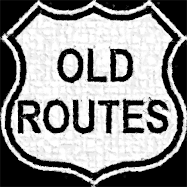In 1901 the railroad came and Tucumcari was born. In 1926 the road in and out of town was numbered US 66.
The city has some of the more famous hotel signs along old 66. The neon 1939 Blue Swallow Motel is a favorite with “refrigerated air.” The artistic rendition of Route 66 and the tailfin-lights of a car is certainly worth seeing as is the historic train station. You can click on the pictures for a bigger view.
Like most old routes cities, they were bypassed by a newer highway. France 24 TV News recently did a story on the downturn of the Tucumcari’s economy and you can see it here. It’s interesting to see the European view on 66’s demise. If you didn’t know better, the story could make you think that 66 was bypassed last month.
Tucumcari was named for Tucumcari Mountain to the southeast of town. This mountain was the inspiration for Radiator Springs Mountain in the movie, “Cars”. You may have seen real life pictures of the area if you watched the TV show, “Rawhide
It’s easy to find old 66 here as they have renamed it Route 66 Boulevard.
View Larger Map
Links
City of Tucumcari
Tucumcari in song, movies and TV
Tucumcari Chamber of Commerce site with more visitor information

